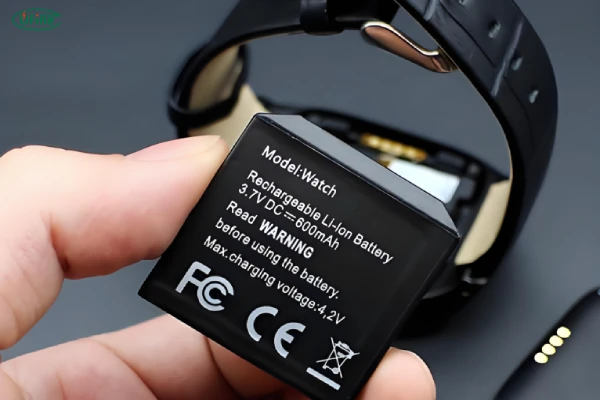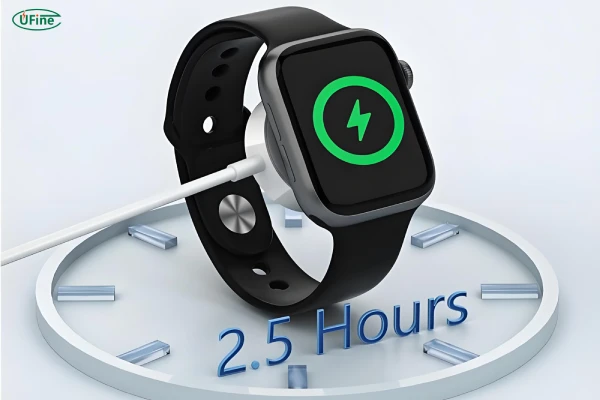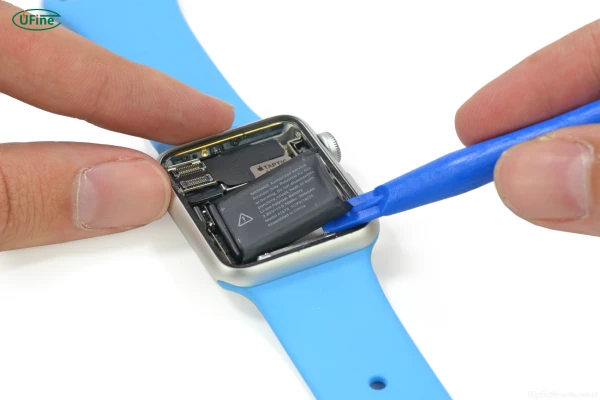Part 1. Types of smart watch batteries
The battery is the heart of your smartwatch. Without it, your device is just a piece of metal and glass. But not all smartwatch batteries are the same. Some last longer, charge faster, and handle extreme temperatures better.
Most smartwatches use rechargeable lithium-based batteries due to their high energy density, lightweight structure, and ability to hold a charge for long periods. Let’s explore the most common types:
🔋 Lithium-Ion (Li-Ion) Batteries
The most widely used battery type in smartwatches.
Offers high energy density, making it ideal for compact devices.
Fast charging but has a limited lifespan (about 300-500 charge cycles).
May experience performance degradation after prolonged use.
🔋 Lithium-Polymer (LiPo) Batteries
More flexible and lightweight than Li-Ion batteries.
Better safety performance due to lower risk of leakage.
Can be molded into different shapes, allowing ultra-thin smartwatch designs.
Generally last longer than Li-Ion batteries with proper care.
🔋 Solid-State Batteries (Future Technology)
Expected to outperform Li-Ion and LiPo batteries in terms of lifespan and safety.
Higher energy density, meaning longer battery life in smaller sizes.
Currently in development and not yet common in consumer smartwatches.
At Ufine Battery, we specialize in custom lithium-ion and lithium-polymer batteries for smartwatches. Our batteries are designed for maximum longevity and efficiency. If you’re a smartwatch manufacturer looking for high-quality power solutions, contact us today!
Part 2. Which smart watch battery has the longest lifespan?
If you want a battery that lasts for years, not just months, you need to understand real-world degradation.
Battery Lifespan Comparison
| Battery Type | Cycle Life (Full Charges) | Degradation Rate | Best For |
|---|---|---|---|
| Li-ion | 300-500 cycles | Loses ~20% capacity after 500 cycles | Budget-friendly smartwatches |
| LiPo | 400-600 cycles | Loses ~15% capacity after 600 cycles | Premium, long-lasting wearables |
| Solid-State | 1,000+ cycles (estimated) | Minimal degradation | Future smartwatches |
Why LiPo Lasts Longer:
-
Stable chemistry (less prone to internal damage)
-
Better heat resistance (slower degradation in high temps)
-
Flexible structure (reduces wear from repeated charging)
Pro Tip: If your smartwatch allows battery replacement, upgrading to a high-quality LiPo battery (like those from Ufine Battery) can double its usable life.
Part 3. Cycle life vs. runtime: what’s the difference?
Many users confuse these two, but they’re not the same thing.
A. Cycle Life (Long-Term Durability)
-
Definition: The number of full charge cycles (0% to 100%) a battery can handle before losing significant capacity.
-
Example: A 500-cycle battery charged daily will last about 1.5 years before dropping to 80% capacity.
B. Runtime (Daily Usage Time)
-
Definition: How long a single charge lasts under normal use.
-
Example: An Apple Watch lasts 18-24 hours, while a Garmin can go 7+ days on one charge.
Key Insight:
-
A battery with high cycle life (like LiPo) will last longer over years.
-
A battery with high runtime (like in Garmin watches) needs fewer charges, indirectly extending lifespan.
Part 4. Smartwatch battery lifespan and run time comparison
Here’s how popular smartwatches compare in real-world usage:
| Smartwatch Model | Battery Type | Avg. Runtime | Cycle Life | Years Until 80% Capacity |
|---|---|---|---|---|
| Apple Watch Series 9 | Li-ion | 18-36 hrs | 500 cycles | ~1.5 years (daily charging) |
| Samsung Galaxy Watch 6 | Li-ion | 30-40 hrs | 500 cycles | ~1.5 years |
| Garmin Venu 3 | LiPo | Up to 14 days | 600 cycles | ~3 years (weekly charging) |
| Fitbit Sense 2 | LiPo | 6+ days | 600 cycles | ~3 years |
Takeaway:
-
Frequent chargers (like Apple/Samsung users) wear out batteries faster.
-
Long-runtime watches (Garmin/Fitbit) last longer because they charge less often.
Part 5. What kills smart watch batteries?
Even the best battery won’t last if mistreated. Here’s what destroys battery health:
🔋 Enemy #1: Heat
-
Why? High temps accelerate chemical degradation.
-
Fix: Avoid leaving your watch in hot cars or direct sunlight.
🔋 Enemy #2: Deep Discharges (0% Battery)
-
Why? Draining to 0% strains the battery.
-
Fix: Charge before it drops below 20%.
🔋 Enemy #3: Fast Charging Every Day
-
Why? High-voltage charging generates heat and stress.
-
Fix: Use slow charging when possible.
🔋 Enemy #4: Always-On Display & GPS
-
Why? These features drain power constantly.
-
Fix: Disable when not needed.
Part 6. How to extend battery lifespan?
Want your battery to last years, not months? Follow these science-backed tips:
Daily Use Tips
- Lower screen brightness and reduce Always-On Display usage.
- Turn off unnecessary features like LTE, Wi-Fi, and Bluetooth when not in use.
- Close background apps to minimize power consumption.
Long-Term Battery Health Tips
- Avoid charging to 100% all the time; aim for 80-90% instead.
- Don’t let the battery drop below 20% frequently.
- Use the original charger to avoid voltage fluctuations.
- Keep the watch at room temperature; avoid extreme heat or cold.
Part 7. How to choose a long-lasting smart watch battery?
When selecting a smartwatch, battery performance should be a priority. Here’s what to consider:
✔ Battery Type – LiPo batteries generally last longer than Li-Ion batteries.
✔ Brand Reputation – Brands like Garmin and Amazfit focus on battery longevity.
✔ Software Optimization – WatchOS and Wear OS impact power efficiency.
✔ Battery Capacity – A larger battery doesn’t always mean better life if the smartwatch has power-hungry features.
If you’re looking for a smartwatch with a long battery life, consider models with LiPo batteries, efficient processors, and power-saving software.
Part 8. FAQS
Can I replace my smartwatch battery if it starts to degrade?
Most modern smartwatches have non-removable batteries, meaning replacement requires professional servicing. Some brands offer battery replacement programs.
Why does my smartwatch battery drain so fast after a software update?
Updates sometimes introduce new features that consume more power. Also, background processes may run for hours after an update. Restarting your device can help.
Does using a wireless charger affect smartwatch battery life?
Wireless charging produces more heat, which can slightly degrade the battery over time. Using a high-quality charger and avoiding overheating helps minimize this effect.
Will using third-party charging cables damage my smartwatch battery?
Yes, it’s possible. Non-certified chargers may supply incorrect voltage or lack protective circuits, leading to faster battery wear or even safety hazards.
How does smartwatch battery life compare to fitness trackers?
Fitness trackers often last longer because they lack power-hungry features like high-resolution displays, LTE, and continuous GPS tracking.
Can extreme cold weather damage my smartwatch battery?
Yes, lithium batteries perform poorly in cold temperatures, leading to faster discharge rates and potential long-term damage. Keeping your watch inside a sleeve or glove in winter can help protect it.
Related Tags:
More Articles

How to Choose the Best Floor Scrubber Battery for Commercial Cleaning?
Selecting the ideal floor scrubber battery ensures a long runtime, rapid charging, and minimal maintenance for efficient commercial cleaning operations.
Battery for Blower vs Battery for Leaf Vacuum: Which One Should You Choose?
Battery for blower vs leaf vacuum—learn the key differences in power, fit, and runtime to choose the right battery for your outdoor tool needs.
How to Choose the Right Battery for Blower?
Choosing the right blower battery? Consider voltage, capacity, chemistry & usage. This guide helps match the best battery for peak performance.
How to Choose the Best Insulated Battery Box for Lithium Batteries?
Choosing the Best Insulated Battery Box for Lithium Batteries? Discover key factors such as size, material, and safety for optimal protection and performance.
7 Critical Elements on a Lithium Battery Shipping Label
What must be on a lithium battery shipping label? Learn 7 key elements to ensure safety, legal compliance, and correct handling across all transport modes.






